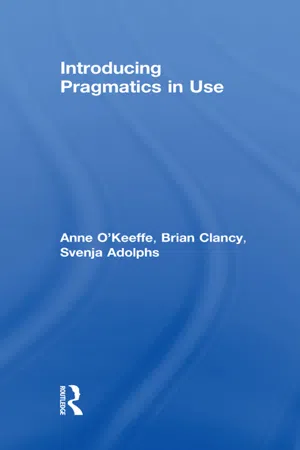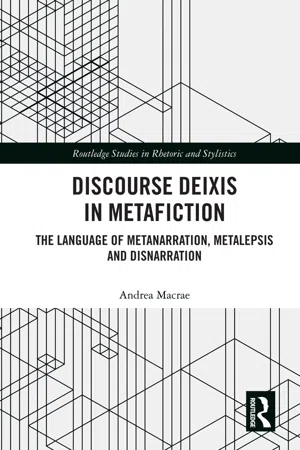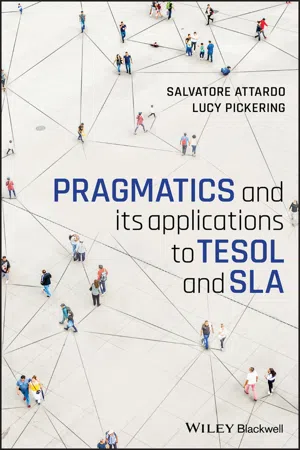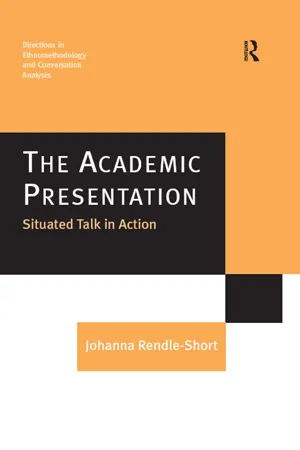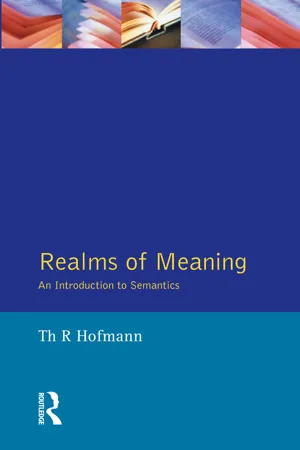Deixis
Deixis refers to the linguistic phenomenon where words or phrases rely on the context of the conversation or the physical location of the speaker and listener for their meaning. This includes words like "this," "that," "here," and "there," which can only be fully understood within a specific context. Deixis is an important aspect of language that helps speakers and listeners navigate communication effectively.
8 Key excerpts on "Deixis"
- eBook - ePub
- Anne O'Keeffe, Brian Clancy, Svenja Adolphs(Authors)
- 2011(Publication Date)
- Routledge(Publisher)
...CHAPTER 3 3. Deixis 3.1 WHAT IS Deixis? As discussed in Chapter 1, the term pragmatics is often used in linguistic research to refer to the study of the interpretation of meaning. Although it has proven difficult to determine an exact definition for the term pragmatics (Levinson discusses the issue over more than 50 pages in his influential 1983 work Pragmatics), a user-friendly definition is that suggested by Fasold (1990: 119) as ‘the study of the use of context to make inferences about meaning’. In this definition, inferences refer to deductions made by participants based on available evidence (Christie, 2000). As we mentioned in Chapter 1, this available evidence is, according to pragmaticists, provided by the context within which the utterance takes place. Therefore, because, according to Levinson (1983: 54), ‘the single most obvious way in which the relationship between language and context is reflected in the structures of languages themselves, is through the phenomenon of Deixis’, Deixis is integral to the study of pragmatics. Derived from the Greek word for ‘pointing’ or ‘indicating’ (deiktikos: ‘apt for pointing with the finger’), Deixis refers to the way in which speakers orientate both themselves and their listeners in relation to the context of a conversation. Deixis enables interlocutors to refer to entities in context, thereby allowing them to identify people and things in relation to the space they are operating in at the moment at which they are speaking. There are a number of grammatical items that encode Deixis, for example, the demonstratives, this, that; first and second person personal pronouns, I, you, we; adverbs of time such as now, then; adverbs of space such as here, there; motion verbs such as come, go; and a variety of other grammatical features such as tense markers...
- eBook - ePub
Discourse Deixis in Metafiction
The Language of Metanarration, Metalepsis and Disnarration
- Andrea Macrae(Author)
- 2019(Publication Date)
- Routledge(Publisher)
...As described by Lyons, by Deixis is meant the location and identification of persons, objects, events, processes and activities being talked about, or referred to, in relation to the spatiotemporal context created and sustained by the act of utterance and the participation in it, typically of a single speaker and at least one addressee. (1977, p. 637) Lyons contrasts the expressions “The church is on the other side of the town hall from where I am looking” and “The church is on the other side of the town hall from the road”. Here only the former “involv[es] a deictic point-of-observation” which he paraphrases as “seen from here”, whereas the latter involves relational but non-deictic orientation in that it is not anchored to a particular perceptual origo (1977, p. 700). To summarise, the two chief characteristics of Deixis which distinguish it from the purely symbolic field are: i) deictic reference is anchored to a perceptual origo, and in turn, ii) interpretation of deictic terms depends upon the addressee relating the deictic terms to one or more dimensions of the context of the utterance—for example, spatial, temporal, or person (i.e. participant relations). What Lyons describes as “relation to the spatiotemporal context created and sustained by the act of utterance and the participation in it” has been further specified here as relation to one or more aspects of the context of utterance, as in some cases only one dimension is relevant to and required for identification of the referent (e.g. the addressee’s knowledge of who the speaker is, when the speaker uses ‘I’, may not require reference to the spatio-temporal aspects of the context). A third characteristic might be proposed: iii) in most cases, deictic terms tend to take on a different referential value each time they are used. The qualification within the third characteristic warrants explanation...
- eBook - ePub
- Anne O'Keeffe, Brian Clancy, Svenja Adolphs(Authors)
- 2019(Publication Date)
- Routledge(Publisher)
...As has been demonstrated, the deictic centre frequently has the speaker as centre; therefore these locations are often relative to the speaker’s position. Notions of place Deixis are commonly expressed using demonstratives (this, that, these, those), deictic adverbs of place (here, there) or verbs of motion (come, go, bring, take). However, locations can also be specified relative to other objects using prepositions of place, such as above, below, left, right, behind or from. Task 4.4 Identifying Place Deictics Identify the linguistic item(s) that represent spatial/locational Deixis in extract 4.10. (4.10) In many languages there exists a fundamental distinction between proximal (or relatively close to the speaker) and distal (non-proximal, sometimes relatively close to the addressee) deictic expressions of place (Diessel, 1999; Levinson, 2004). For example, here and there are crucially tied to the deictic field of the speaker, and the addressee(s) determines the spatial coordinates of the utterance in order to assign meaning. The extent to which context is involved in determining the reference of here is evident in the interaction in extract 4.11 between participants in a biochemistry study group in the MICASE corpus. (4.11) In this extract the participants are discussing whether or not it is important to know the names of certain enzymes. <$3> uses here to here to point to a specific part of a chemical formula that appears to be written down somewhere in the shared immediate context. We have, of course, already encountered the phenomenon of place Deixis previously in this chapter in extract 4.4 when we looked at <$3>’s repeated use of down there. Time Deixis According to Huang (2007: 144), time Deixis ‘is concerned with the encoding of temporal points and spans relative to the time at which the utterance is produced’...
- eBook - ePub
- Sebastian Loebner(Author)
- 2013(Publication Date)
- Routledge(Publisher)
...It consists of things directly and automatically given for speaker and addressee: who it is who produces the utterance, to whom it is addressed, at which time and at which place it is produced. At least this is the case in the standard situation of face-to-face communication. All languages have means of directly referring to immediate elements of the CoU. Among these means are pronouns such as I and you or expressions like here and now. Linguists call such expressions deictic and the general phenomenon Deixis. The use of deictic expressions not only anchors an utterance in the world, it also imposes the perspective of the speaker on the utterance. The speaker forms the so-called deictic centre ; the ‘I’ is the one who decides who is being addressed; where the speaker is is ‘here’; when they speak is ‘now’. In the first part of this chapter, we will consider the three most important deictic relations: relation to the persons involved in the utterance (4.1), to the spatial situation (4.2) and to the time of utterance (4.3). 4.1 PERSON Deixis Person Deixis is Deixis based on the linguistic category of person. The category of person relates to the roles that the participants take in an individual utterance: in the singular, the ‘1st person’ is the speaker, or producer, of the utterance, S for short; the ‘2nd person’ is the addressee, 2 or A; the term ‘3rd person’ subsumes everybody who is neither first nor 2nd person. 3 These roles are called discourse roles. In most languages the discourse roles play a role in grammar; these are languages that have the category of ‘grammatical person’. English is one of these languages: grammatical person plays a role in the choice of personal pronouns and the forms of fnite verbs (she say s ; I am ; you are ; etc.). The most salient linguistic means of person Deixis are systems of personal pronouns. They may differ in the grammatical categories of person, gender, number and formality. Table 4.1 displays the personal pronouns in German...
- eBook - ePub
- Salvatore Attardo, Lucy Pickering(Authors)
- 2021(Publication Date)
- Wiley-Blackwell(Publisher)
...121), whereas in English the distinction can be ignored: “Mary arrived” is non-committal in terms of evidentiality: I may have witnessed it or someone may have told me, or I may have figured it out by some other clue. The second major area of stance to be covered is its indexical nature and for this we will consider the notion of Deixis more broadly. 7.2 Deixis Deictics are “pointers.” The etymology of the word makes it remarkably clear as it goes back to the Greek deiknumi (“to point, to show”) which is related to the Proto-IE root*deik, with the same meaning and is related to Latin digitus meaning “finger,” that is, the pointer by default. Our discussion of Deixis is based largely on Fillmore (1971/1997), which is the classical text on Deixis. The reader will recall from Section 1.1.2 that signs such as “cat” or “house” refer to entities in the real world via a semiotic process which involves a reference to a sign, stored in the mind of the speakers. Deictics refer to something in the real world in a slightly different way: they directly point to the real-world entities they refer to. So, when Pickering is choosing chainsaws at the local hardware store she may say (111) I’ll take this one. pointing at a given chainsaw. So, a word like this literally can be used along with a pointing gesture to select an entity in the real world as the topic of one’s utterance. Obviously, more abstract uses are derived from this original physical sense...
- Johanna Rendle-Short(Author)
- 2016(Publication Date)
- Routledge(Publisher)
...The process of Deixis does not simply involve pointing to something as one says ‘this’ or ‘here’. Successful Deixis involves using all the verbal and nonverbal resources available, such as talk, prosody, gaze, body position, as well of course, the image itself, whether that be on a screen or on a whiteboard. Deixis initially involves setting up an expectation that something is going to be referred to. That expectation is then realised as talk and nonverbal action jointly indicate the exact nature of the referent. Thus the process of Deixis is accomplished through both verbal and nonverbal activities—they both work together to generate reference (Goodwin, 2003). The one does not work without the other. The pointing gesture, in and of itself, does not direct the audience towards the image—the gesture is part of a complete picture that indicates reference. Body position, gaze, hand actions and talk combine with the pointing gesture to produce the referential activity, that enables the audience to know what it is that is being referred to when presenters use deictic expressions such as ‘this’ or ‘here’. The process of Deixis is closely connected with the recipient design of the presentation. The image is brought into prominence and thus made salient not for the presenter, but for the audience. It is the audience who needs to know what it is that presenters are referring to when they use deictic reference terms, such as ‘this’ or ‘here’. Giving salience to images or objects can be done in a number of ways: by making them visible; by talking about the images; by orientating one’s body towards them; by gazing at them; or by pointing to them...
- Jan McAllister, James E. Miller(Authors)
- 2013(Publication Date)
- Wiley-Blackwell(Publisher)
...Crucial to the interpretation of deictic words and phrases are the location of the speaker relative to some other entity, whether the entity is the speaker, the addressee or a third person, and the moment at which the speaker is speaking. Deictic items can be used to signal perceived proximity or remoteness with respect to time, the place of an entity in a narrative, social relations and the speaker's attitude. Reference has to do with the use of noun phrases/referring expressions to draw the attention of listeners or readers to some entity or entities. It is an act, whereas denotation has to do with the information carried by lexical items. Speakers and writers can refer to entities that are given, that is have already been mentioned or are prominent in the immediate context or in the culture shared by speaker or writer and the addressee. Reference may be to entities that are new, that is have not been mentioned or that cannot, in the judgment of the speaker, be (easily) picked up by the addressee. Given entities are specific; new entities may be specific or non-specific. Philosophers focus on whether referring expressions are correct but in ordinary language use many instances of referring are successful without being correct. The interpretation of both deictics and definite noun phrases may involve bridging. The addressee builds a bridge from an apparent deictic target or referent to the intended target or referent, making use of frames of information about some area of a given culture or world. Exercises using clinical resources 11.6. In Section 11.3.2 we noted that it can be challenging to process the ‘shifting Deixis’ associated with direct speech in narrative. Consider the Recalling Sentences in Context subtest of the CELF-Preschool, and look at the items that include direct speech (i.e. words in inverted commas). In which items could shifting Deixis be an issue? 11.7. The following resources involve the clinician asking questions of the client...
- eBook - ePub
Realms of Meaning
An Introduction to Semantics
- Thomas R. Hofmann(Author)
- 2015(Publication Date)
- Routledge(Publisher)
...Chapter 4 Deixis When someone calls for a bit of help, we would normally say ‘I’m coming’ or ‘I’ll come in a moment.’ A Japanese might say, however, ‘Sugu iki-masu’ which translates as ‘I go in a moment’, but he doesn’t mean that he is leaving and refusing to help. Many languages use to go in some cases where English uses to come. So what do these words mean? And why can’t we say ⋆ ‘She went here yesterday’ in ordinary speech? Language would be impossible without a speaker and a hearer. It is not hard, then, to see why interesting things happen with words that are related to the speaker and the person he or she is talking to (the addressee). This is what linguists call Deixis. Deictic or ‘pointing’ words such as this, that and the like are found in all languages and are very useful for ‘referring’ to objects around you. You will even see, if you watch yourself or others, that these words are often accompanied by a pointing gesture – with a finger typically, or if that is too impolite, maybe an elbow, or just the eyes. This and that In perhaps every language, deictic words form systems or patterns that are semantic in nature, so semantics often starts in noticing these patterns and realizing that there must be fundamental units of meaning on which these patterns are based. Japanese has one of the more perfect deictic systems, so let us begin there. The central part of the system includes the following demonstrative expressions. This loses a lot in translation, but just to show what is lost, and how different languages can be, we would have to translate the table above as follows, even though each word in the original has a quite distinct meaning. Spanish distinguishes the rows better. Speakers of Japanese know that the words in the first row belong together, not simply because they all have the same beginning ko- in common, but because they describe something related to the location or territory, physical or psychological, of the speaker...
